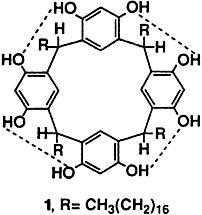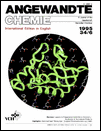A Non-Peptidic Ion Channel with K+ Selectivity
Dr. Yasutaka Tanaka
Department of Materials Science, Faculty of Engineering Shizuoka University Hamamatsu, Shizuoka 432 (Japan) Telefax: Int. code + (53)473-4170
Search for more papers by this authorCorresponding Author
Prof. Dr. Yoshiaki Kobuke
Department of Materials Science, Faculty of Engineering Shizuoka University Hamamatsu, Shizuoka 432 (Japan) Telefax: Int. code + (53)473-4170
Department of Materials Science, Faculty of Engineering Shizuoka University Hamamatsu, Shizuoka 432 (Japan) Telefax: Int. code + (53)473-4170Search for more papers by this authorDr. Yasutaka Tanaka
Department of Materials Science, Faculty of Engineering Shizuoka University Hamamatsu, Shizuoka 432 (Japan) Telefax: Int. code + (53)473-4170
Search for more papers by this authorCorresponding Author
Prof. Dr. Yoshiaki Kobuke
Department of Materials Science, Faculty of Engineering Shizuoka University Hamamatsu, Shizuoka 432 (Japan) Telefax: Int. code + (53)473-4170
Department of Materials Science, Faculty of Engineering Shizuoka University Hamamatsu, Shizuoka 432 (Japan) Telefax: Int. code + (53)473-4170Search for more papers by this authorGraphical Abstract
The resorcinol–octadecanal cyclotetramer 1 forms an ion channel in planar lipid bilayers. A stable conductance level is observed with well-defined transitions between open and closed states. The channel discriminates K+ from Na+ ions as well as cations from anions (for example, K+ from Cl−), as indicated by permeability ratios of 3 and 20, respectively. Rb+ ions block the K+ ion current.
References
- 1See for instance: M. Noda, S. Shimizu, T. Tanabe, T. Takai, T. Kayano, T. Ikeda, H. Takahashi, H. Nakayama, Y. Kanaoka, N. Minamino, K. Kangawa, H. Matsuo, M. A. Raftery, T. Hirose, S. Inayama, H. Hayashida, T. Miyata, S. Numa, Nature 1984, 312, 121.
- 2For voltage-gated K+ channels see: (a) C. Miller, Science 1991, 252, 1092, and references therein; (b) G. A. Lopez, Y. N. Jan, L. Y. Jan, Nature 1995, 367, 179, and references therein.
- 3(a) I. Tabushi, Y. Kuroda, K. Yokota, Tetrahedron Lett. 1982, 23, 4601; (b) U. F. Kragten, M. F. M. Roks, R. J. M. Nolte, J. Chem. Soc. Chem. Commun. 1985, 1275; (c) J.-H. Fuhrhop, U. Liman, V. Koesling, J. Am. Chem. Soc. 1988, 110, 6840; (d) A. Nakano, Q. Xie, J. V. Mallen, L. Echegoyen, G. W. Gokel, J. Am. Chem. Soc. 1990, 112, 1287; (e) F. M. Menger, D. S. Davis, R. A. Persichetti, J.-J. Lee, J. Am. Chem. Soc. 1990, 112, 2451; (f) M. J. Pregel, L. Jullien, J.-M. Lehn, Angew. Chem. 1992, 104, 1695; Angew. Chem. Int. Ed. Engl. 1992, 31, 1637; (g) T. M. Fyles, T. D. James, K. C. Kaye, J. Am. Chem. Soc. 1993, 115, 12315; (h) E. Stadler, P. Dedek, K. Yamashita, S. L. Regen, J. Am. Chem. Soc. 1995, 116, 6677.
- 4 B. Hille, Ionic Channels of Excitable Membranes, 2nd ed., Sinauer, Sunderland, MA, 1992.
- 5 Y. Kobuke, K. Ueda, M. Sokabe, J. Am. Chem. Soc. 1992, 114, 7618.
- 6 1a: Yield 50%; m.p. > 300°C; 1HNMR (90 MHz, CDCl3): δ = 7.22, 6.12 (each s, each 4H; aryl-H), 4.30 (t, 4H; CHR), 2.15, 1.26 (128H; CH2), 0.88 (t, 12H; CH3), 7.5–10.5 (br, 8H; Ar-OH), 3.8 (br, 2H; H2O); MS (FAB): m/z 1441 (M+ + H); correct C,H,O analysis.
- 7(a) Y. Aoyama, Y. Tanaka, S. Sugahara, J. Am. Chem. Soc. 1989, 111, 5397; (b) Y. Tanaka, Y. Aoyama, Bull. Chem. Soc. Jpn. 1990, 63, 3343.
- 8 The experimental procedures were identical to those we used previously [5]. The gating kinetics is not discussed here, but the lifetimes of open and closed states are in the order of seconds to milliseconds.
- 9(a) M. T. Tosteson, D. S. Auld, D. C. Tosteson, Proc. Natl. Acad. Sci. U.S.A. 1989, 86, 707; (b) A. Grove, M. Mutter, J. E. Rivier, M. Montal, J. Am. Chem. Soc. 1993, 115, 5919, and references therein; (c) K. S. Åkerfeldt, J. D. Lear, Z. R. Wasserman, L. A. Chung, W. F. DeGrado, Acc. Chem. Res. 1993, 26, 191. For peptide channels exhibiting one type of conductance see: (d) M. Montal, M. S. Montal, J. M. Tomich, Proc. Natl. Acad. Sci. U.S.A. 1990, 87, 6929; (e) A. Grove, J. M. Tomich, M. Montal, Proc. Natl. Acad. Sci. U.S.A. 1991, 88, 6418; (f) M. R. Ghadiri, J. R. Granja, L. K. Buehler, Nature 1995, 369, 301.
- 10 W. Veatch, L. Stryer, J. Mol. Biol. 1977, 113, 89.
- 11(a) L. Heginbotham, R. MacKinnon, Neuron 1992, 8, 483; (b) S. R. Durell, H. R. Guy, Biophys. J. 1992, 62, 238; (c) S. Bogusz, A. Boxer, D. D. Busath, Protein Eng. 1992, 5, 285; (d) R. A. Kumpf, D. A. Dougherty, Science 1993, 261, 1708.
- 12 P. Guilbaud, A. Varnek, G. Wipff, J. Am. Chem. Soc. 1993, 115, 8298.





